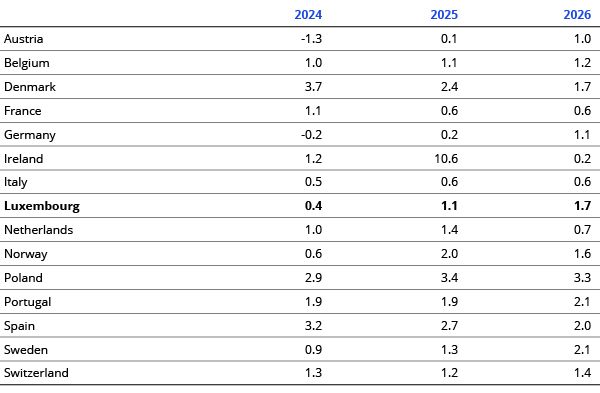A final interest rate cut for 2025?
Inflation remains near target across Europe as central banks appear close to concluding the current interest rate-cutting cycle. In the Eurozone, headline inflation rose to 2.2% in September— driven by a volatile energy component—while core inflation remained unchanged. Underlying price pressures, particularly in services remain elevated, but are expected to moderate in the near term as consumer caution and weak growth weigh on domestic demand.
We expect Eurozone inflation to fall further, potentially dipping below 2% by year-end. This would likely prompt one final rate cut from the ECB in December, bringing the deposit rate to 1.75%.
Resilient labor market despite weak growth and uncertainty
European labor markets remain resilient despite recent weak growth and heightened uncertainty, with unemployment rates below pre-Covid levels across many economies. However, labor market strength may be put to the test as weak external demand and trade tensions weigh on business earnings.
A mixed outlook for consumer spending
While consumer demand has been the primary driver of growth, the outlook is mixed. Households’ savings rates have risen significantly since Covid. As lower interest rates make their fuller impact on households’ finances, and lingering policy uncertainty diminishes further, households’ savings ratio may also decline. While we expect savings ratios to remain above the pre-Covid average, reflecting relatively higher interest rates across the region, the fall in savings intentions could still provide some support to consumer spending. Nevertheless, weak consumer confidence suggests that the higher savings preference may endure.
Trade headwinds to persist
Growing frictions in international trade show a departure from a century long pattern of declining tariffs and trade liberalization, with the effective tariff in the US rising from 2.4% to 17.4% so far this year, although the actual rate may be somewhat lower due to special dispensations agreed.
Trade deals already announced resolve some of the ongoing uncertainty but imply higher tariff rates than those that prevailed at the start of the year. The EU-US trade deal saw tariffs increase to 15% on most EU exports to the US, whilst steel, aluminum and copper remain at 50%. For some sectors, such as automotive, this represents a tariff reduction, from the 25% tariff rate which had been in place since February.
Overall, KPMG estimates suggest tariffs announced so far could reduce EU GDP by up to 1% by the end of 2026.
Fiscal outlook
Public finances across Europe are under strain from rising spending demands and higher debt servicing costs, increasing pressure for medium-term debt sustainability and fiscal consolidation. In June, NATO members pledged to raise defense spending to 5% of GDP by 2035, with 3.5% earmarked for core defense and up to 1.5% for broader security-related expenditures. While dual-use infrastructure may count toward the latter, meeting the 3.5% core target will likely require additional investment in the coming years. At the same time, ageing populations are driving up demand for health and social care, further burdening already stretched public healthcare systems, as well as raising the costs of state pension provision.






